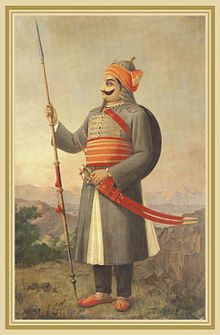Sisodia dynasty: Difference between revisions
Reverted good faith edits by 2405:205:612C:F3C8:0:0:1F05:28A1 (talk): Please see WP:V. (TW) |
Shivpootra (talk | contribs) mNo edit summary Tag: references removed |
||
| Line 15: | Line 15: | ||
== History == |
== History == |
||
{{Mewari Rana}} |
{{Mewari Rana}} |
||
The most notable Sisodia rulers were [[Hammir Singh|Rana Hamir]] (r. 1326-64), [[Kumbha of Mewar|Rana Kumbha]] (r. 1433-68), [[Rana Sanga]] (r.1508–1528) and [[Maharana Pratap|Rana Pratap]] (r. 1572-97). |
The most notable Sisodia rulers were [[Hammir Singh|Rana Hamir]] (r. 1326-64), [[Kumbha of Mewar|Rana Kumbha]] (r. 1433-68), [[Rana Sanga]] (r.1508–1528) and [[Maharana Pratap|Rana Pratap]] (r. 1572-97). |
||
According to the Sisodia chronicles, when the [[Delhi Sultanate|Delhi Sultan]] [[Alauddin Khalji]] attacked Chittorgarh in 1303, the Sisodia men performed ''saka'' (fighting to death), while their women committed ''[[jauhar]]'' (self-immolation in preference to becoming enemy captives). This was repeated twice: when [[Bahadur Shah of Gujarat]] besieged Chittorgarh in 1535, and when the [[Mughal empire|Mughal]] emperor [[Akbar]] conquered it in 1567.<ref name="MBB_2015"/> |
According to the Sisodia chronicles, when the [[Delhi Sultanate|Delhi Sultan]] [[Alauddin Khalji]] attacked Chittorgarh in 1303, the Sisodia men performed ''saka'' (fighting to death), while their women committed ''[[jauhar]]'' (self-immolation in preference to becoming enemy captives). This was repeated twice: when [[Bahadur Shah of Gujarat]] besieged Chittorgarh in 1535, and when the [[Mughal empire|Mughal]] emperor [[Akbar]] conquered it in 1567.<ref name="MBB_2015"/> |
||
Revision as of 10:49, 29 January 2018

The Sisodia are an Indian Rajput clan, who claim Suryavanshi lineage. A dynasty belonging to this clan ruled over the kingdom of Mewar in Rajasthan. The name of the clan is also transliterated as Sesodia, Shishodia, "Sishodia", Shishodya, Sisodya, Sisodhya or Sisodiya.
Origins
Sisodias, like many other Rajput clans, claim origin from the legendary Suryavansha or solar dynasty.[1] Rajprashasti Mahakavyam, a 17th-century laudatory text commissioned by Mewar's ruler Rana Raj Singh, contains a partly mythical, partly legendary and partly historical genealogy of the Sisodias. The work was authored by Ranchhod Bhatt, a Telangana Brahmin whose family received regular gifts from the Sisodias. The genealogy traces the dynasty's origin to the rulers of Ayodhya, starting with Manu, who was succeeded by several emperors from the Ikshvaku dynasty. One ruler Vijaya left Ayodhya for "the south" as per a heavenly command (the exact place of his settlement is not mentioned). He was succeeded by 14 rulers whose names end in the suffix –aditya ("sun"). Grahaditya, the last of these, established a new dynasty called Grahaputra (or Gahlot). His eldest son Vashapa is said to have conquered "Chitrakuta" (Chittor) in 8th century, and adopted the title Rawal, thanks to a boon from Shiva.[2]
Grahaditya and Vashapa (better known as Bappa Rawal) are both popular figures in the Rajasthani folklore.[3] Their successors include people who are known to be historical figures. According to the Rajprashasti genealogy, one of these – Samar Singh – married Prithi, the sister of Prithviraj Chauhan. His grandson Rahapa adopted the title Rana (monarch). Rahapa's descendants spent some time at a place called Sisoda, and therefore, came to be known as "Sisodia".[2]
According to Persian court historians, the Sisodias originated from Noshizad, son of Noshirvan, or Maha Banu, the eldest daughter of Yazdegerd III.[4]
History
| Sisodia Rajputs of Mewar II (1326–1971) |
|---|
|
The most notable Sisodia rulers were Rana Hamir (r. 1326-64), Rana Kumbha (r. 1433-68), Rana Sanga (r.1508–1528) and Rana Pratap (r. 1572-97). According to the Sisodia chronicles, when the Delhi Sultan Alauddin Khalji attacked Chittorgarh in 1303, the Sisodia men performed saka (fighting to death), while their women committed jauhar (self-immolation in preference to becoming enemy captives). This was repeated twice: when Bahadur Shah of Gujarat besieged Chittorgarh in 1535, and when the Mughal emperor Akbar conquered it in 1567.[5]
Frequent skirmishes with the Mughals greatly reduced the Sisodia power and the size of their kingdom. The Sisodias ultimately accepted the Mughal suzerainty, and some even fought in the Mughal army. However, the art and literary works commissioned by the subsequent Sisodia rulers emphasised their pre-Mughal past.[5] The Sisodias were the last Rajput dynasty to form an alliance with the Mughals, and unlike other Rajput clans, never intermarried with the Mughal imperial family. Women from other Rajput clans that had marital relations with the Mughals were disallowed from marrying with the Sisodias.[6] The Sisodias cultivated an elite identity distinct from other Rajput clans through the poetic legends, eulogies and visual arts commissioned by them. James Tod, an officer of the British East India Company, relied on these works for his book Annals and Antiquities of Rajas'han. His widely read work further helped spread the views of the Sisodias as a superior Rajput clan in colonial and post-colonial India.[5] Tod's work is now considered to be unreliable.[7]
See also
References
- ^ Joanna Williams, Kaz Tsuruta, ed. (2007). Kingdom of the sun. Asian Art Museum - Chong-Moon Lee Center for Asian Art and Culture. pp. 15–16. ISBN 9780939117390.
- ^ a b Sri Ram Sharma (1971). Maharana Raj Singh and His Times. Motilal Banarsidass. pp. 2–12. ISBN 9788120823983.
- ^ Dineschandra Sircar (1963). The Guhilas of Kiṣkindhā. Sanskrit College. p. 25.
- ^ Prinsep, James. "Essays on Indian Antiquities, Historic, Numismatic". p. 253.
- ^ a b c Melia Belli Bose (2015). Royal Umbrellas of Stone. Brill. pp. 248–251.
- ^ Melia Belli Bose (2015). Royal Umbrellas of Stone. Brill. p. 37.
- ^ Freitag, Jason (2009). Serving empire, serving nation: James Tod and the Rajputs of Rajasthan. Leiden: Brill. pp. 3–5, 49. ISBN 978-90-04-17594-5. Retrieved 27 July 2011.
